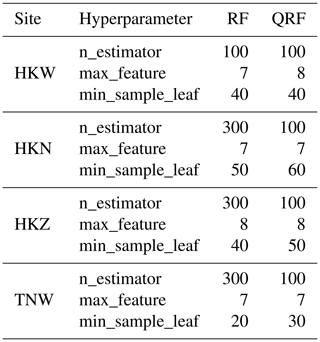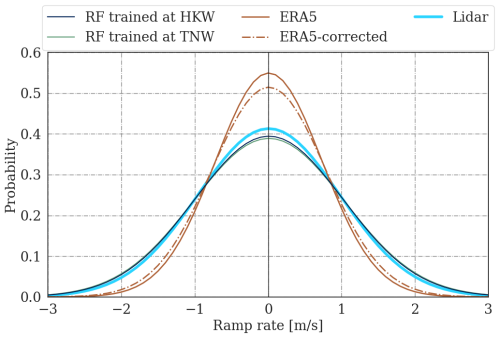the Creative Commons Attribution 4.0 License.
the Creative Commons Attribution 4.0 License.
Characterization of local wind profiles: a random forest approach for enhanced wind profile extrapolation
Farkhondeh (Hanie) Rouholahnejad
Julia Gottschall
Accurate wind speed determination at the height of the rotor swept area is critical for resource assessments. ERA5 data combined with short-term measurements through the “measure, correlate, predict” (MCP) method are commonly used for offshore applications in this context. However, ERA5 poses limitations in capturing site-specific wind speed variability due to its low resolution. To address this, we developed random forest models extending near-surface wind speed up to 200 m, focusing on the Dutch part of the North Sea. Based on public 2-year floating lidar data collected at four locations, the 15 % testing subset shows that the random forest model trained on the remaining 85 % of site-specific wind profiles outperforms the MCP-corrected ERA5 wind profiles in accuracy, bias, and correlation. In the absence of rotor height measurements, a model trained within a 200 km region handles vertical extension effectively, albeit with increased bias. Our regionally trained random forest model exhibits superior accuracy in capturing wind speed variations and local effects, with an average deviation below 5 % compared to corrected ERA5 with a 20 % deviation from measurements. The 10 min random-forest-predicted wind speeds capture the mesoscale section of the power spectrum where ERA5 shows degradation. For stable conditions the root mean squared error and bias are 12 % and 29 % larger, respectively, compared to unstable conditions, which can be attributed to the decoupling effect at higher heights from the surface during stable stratification. Our study highlights the potential enhancement in wind resource assessment by means of machine learning methods, specifically random forest. Future research may explore extending the random forest methodology for higher heights, benefiting a new generation of offshore wind turbines, and investigating cluster wakes in the North Sea through a multinational network of floating lidars, contingent on data availability.
- Article
(3113 KB) - Full-text XML
- BibTeX
- EndNote
Accurate wind speed knowledge across the entire turbine swept area is paramount for the wind energy industry, specifically for site assessment and energy yield calculations (Rohrig et al., 2019). Direct wind profile measurements remain the gold standard, with remote sensing devices like lidars, especially floating lidars, gaining popularity offshore for their ability to reach heights beyond traditional meteorological masts and reduce costs (Gottschall et al., 2017). However, like meteorological masts, they provide wind profiles as point measurements, corresponding to specific locations in space without comprehensive spatial coverage.
In contrast, mesoscale models and global reanalysis datasets offer extensive horizontal coverage but are hindered by spatial and temporal resolutions and the associated errors. Especially in offshore locations, where measurements are often proprietary and scarce, these models remain insufficiently validated (Hahmann et al., 2015). Moreover, due to their large spatial and temporal resolutions, these models tend to smooth out wind speed fluctuations similar to a low-pass filter, thereby inaccurately predicting wind speed variability – an essential input for turbine design (Dörenkämper et al., 2020; IEC, 2019). As a result, wind farm developers commonly adopt a hybrid approach, combining the strengths of both direct measurements and modeling (Carta et al., 2013). This involves conducting measurement campaigns spanning months to a year (Strack et al., 2010), utilizing these data to refine and correct modeled information and extend it over the planned wind turbines' life span. The “measure, correlate, predict” (MCP) method is often employed in this context to localize modeled data at the desired site (Strack et al., 2010). Given that the North Sea exhibits one of the highest levels of wind speed fluctuations in Europe (Bett et al., 2013), there is a need for novel methods, more accurate than the conventional MCP method, to provide more localized wind speed estimates and lower investment risks (Lee and Fields, 2021).
Recent studies have indicated the potential of machine learning (ML) methods, particularly random forests, in extrapolating wind speed to the height of the rotor swept area. Mohandes and Rehman (2018) employed deep neural networks (DNNs) to extrapolate lidar measurements in flat terrain. Taking this methodology a step further, Vassallo et al. (2020) analyzed the sensitivity of DNNs to input features in complex terrains, achieving up to 65 % and 53 % accuracy improvement compared to log-law and power-law predictions, respectively. Yu and Vautard (2022) found the random forest model to outperform the Least Absolute Shrinkage Selector Operator and extreme Gradient Boost in predicting 3-hourly 100 m wind speed based on the ERA5 inputs with a root mean squared error (RMSE) of 0.525 m s−1 when validated against ERA5 wind speeds at 100 m. Liu et al. (2023) compared the random forest predictions against the power-law method, validated using onshore profiles measured by a radiosonde, and showed the superiority of random forest in RMSE and correlation coefficient. They extended this study by combining the power-law and random forest methods, achieving higher performance than each stand-alone method (Liu et al., 2024).
Notably, these studies trained and tested machine learning models at the same location. Bodini and Optis (2020b) argued that this approach is neither fair nor practical. It is unfair because conventional models, e.g., log-law, power-law, or mesoscale models, do not see the wind speeds at the heights of prediction, and it is impractical because there is no need to predict wind speed where the wind profiles are already known, i.e., at the training location. Hence, they introduced the round-robin validation method to the literature, defined as testing the ML model at a location distant from the training. They implemented this validation method on data collected at four onshore locations in a 100 km wide region in the USA. They showed that the random-forest-predicted wind profiles fed with near-surface measurements and wind speed at 65 m can improve the predictions of the log and power law by 25 %, which is reduced to 17 % when the round robin is accounted for. Random forest has also been used to vertically extrapolate wind speed offshore. Optis et al. (2021) utilized two 83 km apart floating lidars in the North Atlantic of the US offshore area to develop random forests, extending near-surface speed up to 200 m and evaluating the results on a climatological level. The round-robin approach increased the unbiased RMSE by 6 %–9 % but still outperformed the Weather Research and Forecasting (WRF) model in all stability conditions, seasons, and times of day. In a similar vein, Rouholahnejad et al. (2023) adopted the round-robin approach to validate random forest models, extending wind speed up to 300 m. They utilized fixed lidars on three offshore platforms in a 300 km wide region in the North Sea. Their round-robin approach resulted in a 14 % improvement in the mean absolute error for the region-optimized WRF model. Hatfield et al. (2023) also considered the round-robin approach to extrapolate satellite wind speed retrievals from 10 to 100 m using random forest models in the North and Baltic Sea, achieving a 35 % improvement in RMSE compared to NEWA (New European Wind Atlas), albeit facing the challenge of low data availability from satellites (defined by two to four overpasses per day only). The evaluation of the performance of the random forest algorithm is not only limited to the accuracy of the predicted time series. Bodini and Optis (2020a) and Hallgren et al. (2024) showed that random forest is also able to capture low-level jets, an important phenomenon for wind energy applications. These studies have showcased the potential of random forests in accurately extending the wind profile in space; however, they do not address its ability to capture wind speed variability. To bridge this knowledge gap, this work will address the following research questions: firstly, how accurately can random forest predict wind speed variability and structures of different frequencies? And secondly, how does random forest compare with the currently used MCP method in the resource assessment context?
To address these questions, we developed a random-forest-based methodology using measured wind profiles in the North Sea, aiming to overcome the issues associated with the low temporal and spatial resolution of ERA5 and provide more localized wind speed predictions. In Sect. 2, we introduce the floating lidar settings near the Netherlands coast, proposing two random-forest-based methodologies using near-surface measurements to predict the wind profile up to 200 m. Our validation process involves comparing the ML model with MCP-corrected ERA5 profiles, elaborated upon in this section. Section 3 presents the validation results and explores horizontal extrapolation via a round robin to test the ML model's robustness and generality in the region. These two validation approaches contribute to our understanding of random forest's potential in improving conventional correction methods for site resource assessment. The results are discussed in Sect. 4. Finally, Sect. 5 summarizes and concludes this study, followed by insights into the future of this research field.
In this section, we describe the collected observations and present a methodology to develop a model for extending wind profiles at four offshore sites located in the Dutch part of the North Sea. The model's predictions are benchmarked against wind profiles obtained from ERA5 pressure levels, and both are validated against lidar measurements at the site.
2.1 Observational data
A reliable dataset is key to train and validate a data-driven model. In this study, we utilize measurements obtained by the SEAWATCH Wind Lidar Buoys (SWLBs) deployed by Fugro Norway AS within the wind farm zones of Dutch waters (Netherland Enterprise Agency, 2023). The SWLB, also referred to as a floating lidar system (FLS), collected wind and wave data at four specific locations: Hollandse Kust (west, noord, zuid) and Ten noorden van de Waddeneilanden, in this study referred to as HKW, HKN, HKZ, and TNW, respectively (see Fig. 1). These systems undertook verification tests and passed the acceptance criteria provided by the roadmap for commercial acceptance of floating lidar (DNVGL, 2023; Carbon Trust, 2024).
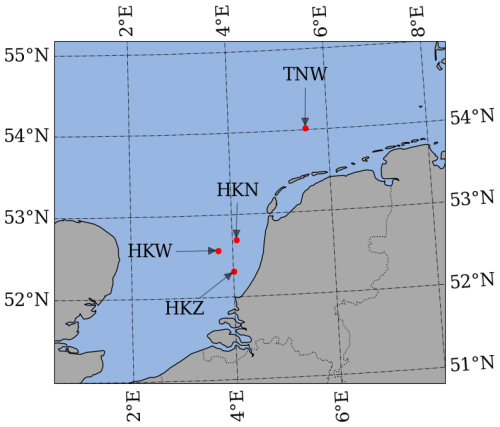
Figure 1Map showing the locations of the sites. HKW, HKN, HKZ, and TNW are acronyms for Holland Kuste west, noord, zuid, and Ten noorden van de Waddeneilanden.
Each SWLB is equipped with a sonic anemometer, which measures wind speed and direction at 4 m a.m.s.l. (above mean sea level). Additionally, a ZX lidar system (previously ZephIR) is mounted on the buoy. This continuous wave (CW) lidar system measures wind speed and direction at 10 ranges between 30 and 250 m a.m.s.l. For the HKW and TNW sites, wind speed is measured up to 250 m, while for HKN and HKZ, measurements extend up to 200 m. To maintain uniformity in our analysis, we have opted to standardize the highest wind speed height to 200 m across all sites, ensuring consistency in our study.
In addition to wind speed and direction, the Vaisala air pressure, temperature, and humidity sensors, installed on the FLS, measure the atmospheric conditions. The water temperature is measured at 1 m below the surface, which we take as the sea surface temperature (SST). All variables are available at a 10 min resolution and are time-stamped at the end of each averaging period. The measured variables used in this study, along with their associated heights, are summarized in Table 1. We used the lidar wind direction at 100 m to exclude the wind sectors where wind farms were operating nearby in order to remove their wakes. Detailed information regarding the location, duration, and data availability is listed in Table 2. The data availability corresponds to the concurrent lidar profiles and the met station measurements after applying the wind sector filter. It is important to note that between the two (at HKN, HKZ, TNW) or three (at HKW) deployed FLSs, the one with the highest data availability is chosen for this study and no data gap filling incorporating neighboring buoys or other data sources is implemented. However, the data gap of sea surface temperature on buoy A at HKN starting from 12 January 2019 for 1.5 months is filled with the one measured by buoy B. We assumed that the sea surface temperature is fairly constant over a distance of 2 km.
Table 1Variables measured by the floating lidar systems (FLSs) in this study, along with their associated heights. This information applies uniformly to all FLS units used, given their consistent and similar structure. The notation “a.m.s.l.” signifies above mean sea level.

2.2 Reanalysis data
The proposed methodology is benchmarked against ERA5, the state-of-the-art fifth-generation reanalysis dataset developed by ECMWF. ERA5 combines historical measured data with numerical models using the IFS Cycle 41r2 data assimilation model in 12 h windows to provide hourly atmospheric variables since 1940 (Hersbach et al., 2023). It offers a spatial resolution of 0.25°×0.25°, covering the entire globe, hence making it a powerful tool to be used for wind resource assessment, energy yield calculations, or climate change studies. In the specific region of this study, the spatial resolution corresponds to 28×17 km (latitude and longitude).
We extracted ERA5 pressure-level data available at the grid point closest to the buoy. These profiles are then interpolated to obtain the horizontal wind speed at the desired heights by means of fitting a monotone cubic function to the wind profile. The ERA5 wind profiles are corrected based on the method elaborated in Sect. 2.4.
2.3 Random-forest-based models
In this study, we introduce two models based on the random forest algorithm: the random forest regressor (Breiman, 2001) and quantile regression forest (Meinshausen, 2006). These models are employed to extend wind speed measurements collected by the sonic anemometers. Our methodology involves randomly selecting a continuous 15 % of the data each month for testing, while utilizing the remaining data for training the models. It is important to note that fully random splitting assumes that the dataset is representative, with observations being independent and identically distributed – conditions that do not hold in our case. Therefore, our approach prevents the introduction of artificial correlations between the testing and training datasets, ensuring the preservation of the underlying seasonality, while still allowing for accurate model evaluation. To tune the hyperparameters, we chose a 15 % continuous subset within the training period and optimized for the RMSE of this subset. Table 3 provides the hyperparameters for both random forest regressor and quantile regression forest models at all sites.
We conducted both same-site and round-robin validations for each model. In “round-robin validation”, the model is applied to locations where it was not initially trained. This approach extends wind profiles spatially. Meanwhile, “same-site validation” extends the near-surface wind speed vertically (Bodini and Optis, 2020b).
The random forest models' outputs and the measured data are downsampled to 1 h to match the temporal resolution of ERA5 and stamped in the middle of the period.
2.3.1 Random forest regressor – RF
The random forest algorithm consists of multiple regression decision trees, each trained on bootstrapped data. This ensemble approach enhances the robustness of the model. Decision trees, which are a type of supervised learning model, make decisions by recursively splitting the data at each node based on the best feature. The best feature is determined by its ability to minimize the mean squared error when used to split the data into subsets. The splitting process continues until a specific criterion is met, at which point a node becomes a leaf. Each leaf in the tree can contain multiple observations (see Fig. 2).
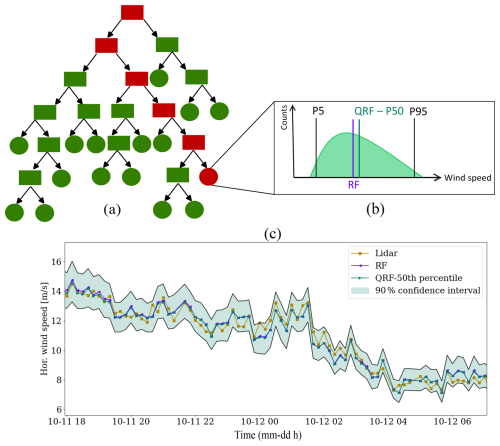
Figure 2Overview of the random forest regressor (RF) and quantile regression forest (QRF). Panel (a) depicts the structure of an example tree, with the red path indicating the route taken by a testing sample. Panel (b) illustrates the sample distribution of the leaf node where the testing sample landed, highlighting distinctions between RF and QRF predictions. Panel (c) presents the actual predictions of RF and QRF models trained at HKW, along with the confidence interval derived from the QRF model.
In a random forest model, the prediction of a regression tree is the conditional mean of the observations within the corresponding leaf that the test sample falls into when traversing down the tree. By averaging the predictions of multiple trees, we obtain the prediction of the random forest model. We used the RandomForestRegressor class from sklearn (Pedregosa et al., 2011).
2.3.2 Quantile regression forest – QRF
In contrast to random forest, where only the mean of the observations in the leaf nodes is retained, a quantile regressor forest preserves the entire data distribution. As a result, the prediction of each tree in a quantile regressor forest corresponds to the desired conditional quantile of the observations at each node. This is particularly useful, as it provides information regarding the confidence interval and allows for the use of the median of the observations to predict the profile, rather than relying on the mean as in the case of random forest. We used the RandomForestQuantileRegressor class from the sklearn_quantile package (Roebroek, 2022), which is programmed based on an algorithm proposed by Meinshausen (2006). The hyperparameters used to create the quantile regression forests are listed in Table 3. We used the minimum sample leaf to ensure that the median is representative by having a sufficient number of samples at each leaf.
2.4 Measure, correlate, predict
The “measure, correlate, predict” (MCP) method is an established technique used in wind resource assessment to estimate long-term wind characteristics at a specific location (Carta et al., 2013; Rogers et al., 2005). Due to the high cost of measurement campaigns, especially offshore, wind data are typically collected for a shorter period (typically 1 year) and then correlated with reference data from nearby locations or reanalysis/mesoscale data. This correlation helps correct the reference data in the absence of in situ measurements, providing a more accurate representation of long-term wind characteristics at the specific location.
In this study, we used the correlation between the ERA5 and measured wind speeds during training to correct the ERA5 testing subset for the same-site approach. For each height individually, we employed a two-parameter linear regression model (slope and intercept) by minimizing the least squared error with respect to the training subset. Subsequently, we utilized the derived slope and intercept values to adjust the testing subset accordingly. This approach ensures a fairer comparison between ERA5 and the random forest model since both models have and use knowledge about the training subset. In this study, the corrected ERA5 wind profiles are referred to as ERA5-corrected.
2.5 Statistical parameters
To assess the accuracy of wind speed predictions, we employed standard error metrics. Additionally, we computed ramp rates to gauge wind speed variability and analyzed the power spectrum to gain insights into the underlying structures present in the wind data.
2.5.1 Error metrics
We used the root mean squared error (RMSE), mean absolute error (MAE), bias, and coefficient of correlation R2 as defined below to estimate the overall performance of the predicted time series.
where and are the predicted and measured wind speed at time stamp t, and is the mean observed wind speed over time.
2.5.2 Wind speed ramp rate
To evaluate the ability of the models to capture the variability of the site, we calculated the ramp rate as the change in the wind speed in a 1 h period (Milan et al., 2014):
The temporal resolution of the concurrent dataset is 1 h, and hence we present the hourly ramp rates. But to gain a general understanding of the hourly fluctuations, we calculated the mean absolute hourly ramp rate as
2.5.3 Power spectral density
The power spectral density (S) was computed using the Fourier transform (ℱ) of the detrended horizontal wind speed as follows:
where T is the period, and N is the number of samples. The defined S in Eq. (7) is for positive frequencies, representing the one-sided spectrum. To smooth the spectrum, Hamming windows of 30 d without overlap were applied.
In this study, we present the measured and modeled S for the entire data period, approximately 2 years for each site. This approach allows for a more continuous time series and helps avoid filling gaps. It is important to note that we did not apply the RF model if it had seen the 15 % training subset to ensure unbiased spectral comparisons.
2.6 Bulk Richardson number
Atmospheric stability refers to the condition of the atmosphere in terms of its tendency to resist vertical motion or mixing of air masses. The bulk Richardson number (RB) relates the buoyancy force to the shear force and can therefore give insights on the stability condition. We calculated RB described by Eq. (8), where θv and g are the virtual potential temperature and the acceleration due to gravity, respectively. z is the height (here 4 m) and Uz represents the horizontal velocity at this height (Stull, 1988). Here we took the parameters at sea surface and at height z and assumed a no-slip condition at the sea surface (zero velocity). For a more detailed derivation, we refer to Appendix A.
Having the bulk Richardson number, the stability parameter (ζ) can be estimated as follows (Grachev and Fairall, 1997):
where C1 and C2 are 10 and 5, respectively. Finally, the Monin–Obukhov length (L) can be calculated as
L was utilized in the post-processing phase to examine the impact of stability on the predictions. The samples are categorized as stable if and unstable if . The choice was based on literature conventions, where ranges such as () and () are common for very stable (very unstable) and stable (unstable) conditions (Argyle and Watson, 2014; Motta et al., 2005). In this study, we do not distinguish between stable (unstable) and very stable (very unstable) conditions, as we use this classification primarily for error characterization.
In our investigation, we implemented the proposed methodology by training four distinct random forest models across four geographically diverse sites. This section starts with a detailed discussion of the crucial features embedded in these models. Subsequently, we present and compare the predicted wind profiles with the corresponding ERA5 profiles. To evaluate model performance, lidar profiles serve as ground truth, and an array of performance metrics is computed. Furthermore, a meticulous analysis of error characteristics provides profound insights into the potential of the applied machine learning algorithms in terms of wind speed variability and power spectrum.
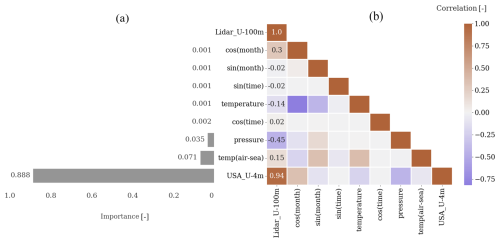
Figure 3Importance of each input considered by the random forest regressor (a) and correlation of input variables with lidar-measured wind speed at 100 m (b). The data captured at HKW were used for these plots, and similar behavior was observed across different locations.
3.1 Features
The normalized importance of each input for the random forest algorithm, as depicted in Fig. 3a, is determined by its role in reducing squared error. Consistent with established literature (Optis et al., 2021; Bodini and Optis, 2020b), our study reaffirms that near-surface wind speed stands out as the most crucial input. Our analysis further underscores the significance of the air–sea temperature difference as a proxy for stability, aligning with prior research emphasizing its importance (Optis et al., 2021; Hatfield et al., 2023).
The alignment of feature importance with the correlation table, as illustrated in Fig. 3b, provides a compelling indication of the random forest algorithm's effectiveness in identifying relevant variables and partitioning the data accordingly.
3.2 Wind speed reconstruction
The two random-forest-based models, RF and QRF, were supplied with the aforementioned variables to predict wind speeds at elevations considerably exceeding the input heights (ranging from 30 to 200 m). Two distinct validation approaches were employed: same site and round robin.
In the same-site validation, the machine learning models were tested at the locations where they underwent training. The resulting wind speed profiles were benchmarked against corrected ERA5 profiles. This validation methodology ensures that the models are assessed in regions where they possess knowledge of the wind speed during the training time stamps.
Conversely, the round-robin validation involved a comparison against ERA5 outputs directly. In this case, the machine learning models were tested at locations spanning distances of 27 to 215 km from their training sites. The efficacy of the models in predicting wind speeds at locations significantly distant from the training sites is thus rigorously evaluated.
3.2.1 Same-site validation
The wind profiles obtained through the same-site validation at the HKW site are illustrated in Fig. 4. In Fig. 4a, the average profile predicted by the RF model exhibits a notable alignment with the lidar average profile. Conversely, the QRF model and corrected ERA5 profiles slightly underestimate the wind speed. To quantify this bias more concretely at 100 m, Fig. 4c presents a Gaussian distribution fitted on the error density histogram. The mean of this distribution, representing the bias at 100 m, is −0.01 m s−1 for RF and −0.05 m s−1 for corrected ERA5. Notably, the random-forest-based models demonstrate a narrower error distribution with a standard deviation of 0.64 m s−1, indicating a 75 % reduction compared to corrected ERA5. This narrower distribution contributes to a lower RMSE, as depicted in Fig. 4b.
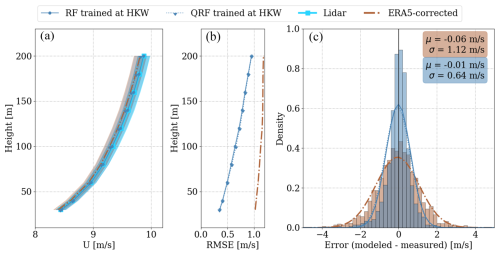
Figure 4Same-site validation at the HKW location: average wind profiles (a), RMSE profile (b), and the error probability density function (PDF) at 100 m (c) for the testing subset, comprising 2388 1 h averages. Wind profiles are shaded with the standard error of the mean, and error histograms are binned into 0.2 m s−1 intervals.
The RMSE of machine learning (ML)-predicted wind speeds remains comparable for both RF and QRF, exhibiting an increase with height (50 % from 100 to 200 m) where the conditions can become decoupled from surface-measured variables. This was also observed in prior studies (Bodini and Optis, 2020b; Hallgren et al., 2024). In contrast, corrected ERA5 shows a weaker dependency of RMSE on height, indicating consistent modeling of processes across all elevations. However, the RMSE of ERA5 wind speeds surpasses that of random-forest-based models at all heights, averaging a 40 % higher value. This underscores the potential of the random forest algorithm for filling the lidar gaps during a floating lidar campaign, given that the met station collects data during the lidar gap.
3.2.2 Round-robin validation
In the round-robin validation conducted at HKW, the ML models trained at TNW, HKN, and HKZ were supplied with input variables at HKW, and their predicted wind speeds were compared with ERA5 outputs. The outcomes are depicted in Fig. 5. Notably, the QRF-predicted average wind speeds are consistently slower than those predicted by the RF model across all training locations. Models trained at TNW exhibit a positive bias, growing with height, while those trained at HKN and HKZ display a negative bias. This discrepancy may be attributed to the higher average wind speeds at TNW, which are 0.32 and 0.74 m s−1 greater than those at HKN and HKZ, respectively (as per data presented in Table 2). The uncorrected ERA5 average profile exhibits a relatively constant negative bias for all heights, surpassing the bias of ML models in absolute value, except for ML models trained at HKN and at higher elevations (Fig. 5a).
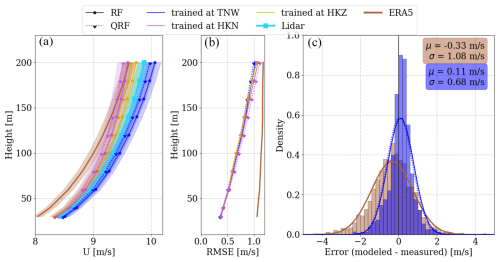
Figure 5Round-robin validation at the HKW location: average wind profiles (a), RMSE profile (b), and the error probability density function (PDF) at 100 m (c) for the testing subset, comprising 2388 1 h averages. Wind profiles are shaded with the standard error of the mean, and error histograms are binned into 0.2 m s−1 intervals.
Examining the ML models trained at TNW and the ERA5 error distributions at 100 m (Fig. 5c), it is evident that the spread of the ML error distribution is akin to the same-site approach (0.68 m s−1), albeit with a slightly larger mean (12 %). This marginal overestimation is noteworthy, considering the geographical distance between training and testing locations (202 km). The mean of the ERA5 error distribution at 100 m is −0.33 m s−1, which is 3 times larger in absolute value than that of the RF model trained 202 km away.
The RMSE of all round-robin ML models applied at the HKW site is very similar, on average 7 % larger than the same-site approach. However, it is crucial to highlight that all round-robin ML models consistently outperform ERA5 in RMSE, indicating a significant improvement (37 %). This underscores the robustness and potential of the proposed ML methodology in horizontally extrapolating wind profiles.
It is noteworthy that the MCP correction of ERA5 wind speeds reduced the bias to 0.07 m s−1 (by 61 %) across all heights. However, its impact on RMSE was limited (0.8 %). Hence, we recommend considering the random forest models for site assessment calculations if offshore near-surface measurements are available in the region, even at a distance of 200 km.
3.3 Error analysis
To evaluate the overall performance of the random forest model, three key performance metrics are presented in Fig. 6. The depicted metrics include bias, RMSE, and the coefficient of determination (R2). These metrics collectively indicate a degradation in model performance as the application distance from the training locations increases. In the case of same-site validation (distance = 0), the bias of the machine-learning-based models ranges between −0.09 and 0.04 m s−1. However, it expands to −0.37 to 0.34 m s−1 when the models are trained 200 km away. ERA5 systematically underestimates the wind speed in the North Sea (also noted by Dörenkämper et al., 2020), even to the extent of −0.58 m s−1. But with correction, the bias lies between −0.07 and 0.07 m s−1. It is advisable to maintain a minimum distance to training when applying the random forest model to ensure a performance comparable to ERA5 in terms of bias.
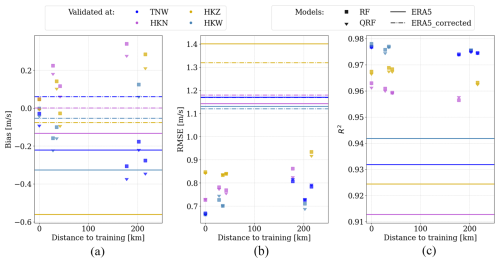
Figure 6Dependence of errors on the distance between training and testing sites, with horizontal lines indicating ERA5 error metrics pre- and post-correction at the four sites for comparison.
Additionally, RMSE is also observed to correlate with the distance to training, as it grows from 0.73 to 0.81 m s−1 when the model is trained 170–215 km away (Fig. 6b). However, the random forest models trained at all distances consistently outperform ERA5 outputs, both before and after MCP correction.
Furthermore, the random forest models have an R2 of 0.97 for same-site implementation, which drops slightly (0.2 %) with a training distance of 200 km (Fig. 6c). Nevertheless, even the ML models trained the furthest (up to 215 km away) outperform ERA5 by 4.4 % in terms of R2. It is pertinent to note that MCP correction does not alter the R2 values due to its linear characteristics.

Figure 7MAE dependency on wind speed (a) and direction (b) at 100 m at the HKW location. Error metrics are binned into 1 m s−1 and 10° intervals for the left and right panels, respectively. The background shading illustrates the distributions of measured wind speed and direction in gray.

Figure 8Bias dependency on wind speed (a) and direction (b) at 100 m at the HKW location. Error metrics are binned into 1 m s−1 and 10° intervals for the left and right panels, respectively. The legends are the same as in Fig. 7.
Figures 7 and 8 show that both the same-site (blue) and round-robin (green) implementations of the RF model exhibit the highest precision and accuracy for wind speeds ranging from 4 to 20 m s−1, a range frequently encountered in practice. The results were similar for the QRF model (not shown). The bias of ERA5 appears to increase with wind speed. However, it can be effectively corrected even for wind speeds up to 19 m s−1 (Fig. 8a).
Figure 7b shows that both models demonstrate a higher MAE for winds coming from the southeast, corresponding to the coastal region. ERA5 has previously shown limitations in resolving coastal effects due to its spatial resolution (Rubio et al., 2022). The MAE in this wind sector also appears to be higher for the random forest models. This is the case for the TNW site with a different coastal direction as well (not shown). Nevertheless, the MAE in this section is 0.5 m s−1 lower than that of ERA5, indicating an improvement in performance.
3.4 Wind speed variability
The ramp rate serves as a metric capturing the variability of wind speed over time. Hourly ramp rates were calculated to quantify the extent of wind speed changes within 1 h. Datasets with higher temporal resolution, such as those measured and modeled by random forest, were down-sampled to match the resolution of ERA5. Figure 9 illustrates a normal fit to the ramp rate distribution at the HKW site at 100 m for the testing samples.
Both the same-site and round-robin predictions of the random forest model exhibit good alignment with the measurements in terms of hourly variability. In contrast, ERA5 displays a narrower distribution compared to the lidar, indicating a deficiency in properly modeling hourly variability. Notably, after MCP correction, the distribution becomes marginally wider, bringing it closer to the measurements.
The ramp rate results are quantified in Table 4, where μ is the mean of the absolute ramp rates and σ the standard deviation of the Gaussian distribution, also shown in Fig. 9. ERA5 hourly wind speed variability shows an underestimation of 27 % and 28 % in the mean and standard deviation, which is reduced to 22 % when MCP correction is incorporated, indicating an improvement in ERA5's ability to capture hourly wind speed changes.
Contrastingly, the random forest algorithm appears to accurately model wind speed variability with only a 4 % to 5 % overestimation for both the same-site and round-robin approach. The low spatial and temporal resolution of ERA5 may contribute to the observed larger deviation in the mean and standard deviation of ramp rates. This emphasizes the impact of spatial grid characteristics on the variability representation within ERA5. The lower deviation in RF might be influenced by the fact that RF models are trained on point measurements, leading to a more localized understanding of wind variability.
3.5 Spectral analysis
Although it deviates from reality, scientists often approximate the wind speed signal as the superposition of waves with different frequencies to gain a physical understanding of eddy sizes. We conducted a comparison between the measured power spectral density and the modeled ones at the TNW site at 100 m, as depicted in Fig. 10. The plot represents 2 years of data at TNW (not a testing subset). Consequently, only predictions of the random forest model developed at HKW are shown and cross-compared with the non-corrected ERA5 predictions.
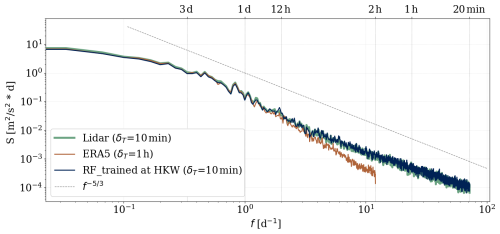
Figure 10Power spectral density at 100 m at TNW, calculated as described in Sect. 2.5.3. δT represents the temporal resolution of the dataset.
As previously mentioned in Sect. 3.4, ERA5 faces challenges in capturing wind speed variability due to its resolution. In fact, we do not expect ERA5 to resolve the mesoscale range of the spectrum thoroughly, given its resolution. Figure 10 confirms this, illustrating a degradation of energy for higher frequencies but good alignment for low frequencies, also shown by Meyer and Gottschall (2022). On the other hand, the random forest model trained 202 km away from TNW was able to capture eddies as small as the lidar could.
3.6 Atmospheric stability
In the final phase of our investigation, we focused on evaluating the performance of machine learning models under various stability regimes. We estimated the Monin–Obukhov length based on the bulk Richardson number as explained in Sect. 2.6. Figure 11 shows the distribution for all sites. We used the criteria elaborated in Sect. 2.6 to classify the predictions shown in Figs. 12 and 13. Figure 12 shows that machine learning models demonstrate increased accuracy in predicting wind speeds during unstable conditions, consistent with findings from Optis et al. (2021) and Bodini and Optis (2020b). Comparing stable and unstable conditions, we observe that the RMSE and bias are 12 % and 29 % larger, respectively, for stable conditions. This discrepancy is attributed to the decoupling effect at higher heights from the surface, influenced by lower turbulent fluxes in the vertical direction, during stable stratification.
Table 4Ramp rate statistics at 100 m: μ corresponds to the average of the absolute change in the wind speed in a 1 h period. σ is the standard deviation of the normal fit to the ramp rate distribution.
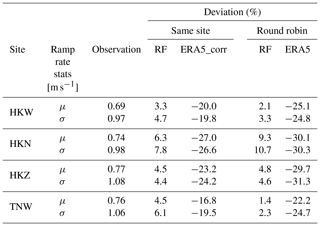
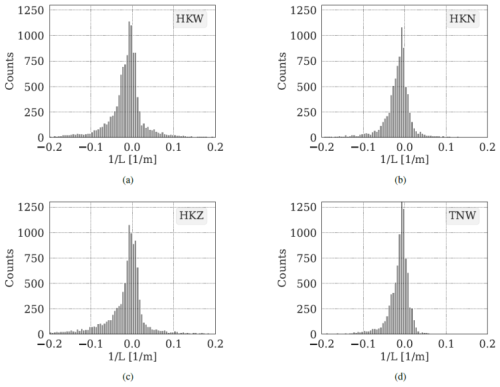

Figure 12Box plot depicting the RMSE (a) and bias (b) for RF and QRF predictions in stable and unstable conditions across all heights, with variations attributed to different locations.

Figure 13Box plot depicting the RMSE (a) and bias (b) of RF for same-site and round-robin validations in stable and unstable conditions across all heights, with variations attributed to different locations.
Figure 13 demonstrates the dependency of the random forest performance considering the two validation approaches under distinct stability regimes. As detailed in Sect. 3.3, the round-robin approach consistently yields less accurate results than the same-site validation, irrespective of the stability regime (Fig. 13a). Interestingly, the decline in accuracy when applied away from the training location cannot be solely attributed to atmospheric stratification, as the proportionate decrease in accuracy remains consistent for both stable and unstable conditions. The transition to the round-robin approach introduces an increase in bias in absolute value, with a slightly more pronounced effect observed for stable conditions (Fig. 13b).
In this study, we investigated the performance of the random forest algorithm on vertical extension of buoy wind profiles. We focused on how accurate the random forest can predict the wind speed variability and capture different structures, where ERA5, commonly used for site assessment, shows inefficacy (Dörenkämper et al., 2020; Meyer and Gottschall, 2022). We proposed a methodology to assimilate near-surface measurements into a model based on two machine learning algorithms: the random forest regressor (RF) and quantile regression forest (QRF). While RF is a well-researched method, QRF is introduced to the wind energy literature for the first time. QRF predictions generally trend slightly lower than those of RF, exhibiting a similar performance when validated against lidar measurements. The advantage of QRF lies in reporting the desired uncertainty as a by-product, albeit at the cost of a longer modeling time. For benchmarking, we chose the ERA5 dataset and corrected it using the “measure, correlate, predict” (MCP) method, a common method for long-term extrapolations in site assessment calculations. The MCP method is known to have low computational effort, which can offer advantages over more computationally intensive ML methods. The computation time for the random forest model is highly dependent on hyperparameters, particularly the number of trees. In our study, the training time per location ranged from 21 to 77 s, demonstrating the model's computational efficiency.
The hyperparameters of the random forest algorithm determine the structure and quantity of trees in the model. These parameters set the convergence criteria for terminating data splits and subsequently using the mean value of the population within a leaf node as the predictive output. When the input features effectively capture the underlying system dynamics, a shallow tree structure can yield accurate predictions. Upon visualizing a specific decision tree, we observed a clear stratification where time stamps associated with higher wind speeds predominantly occupied one side of the tree, while lower wind speeds were clustered on the other side. This outcome is likely influenced by the frequent utilization of the 4 m wind speed feature within the algorithm. In regions characterized by unstable stratification, it is plausible that the decision trees are inherently shorter, given that surface wind speed may serve as a robust indicator of the wind profile. Despite the absence of explicit physical modeling within the machine learning framework, the algorithm demonstrated an ability to organize the data in a manner consistent with established physical principles.
The top environmental variables that the wind speed aloft correlates with are near-surface wind speed, air–sea temperature difference, and pressure. This is well captured by the random forest, as these have the highest impact on minimizing the least squared error (see Fig. 3). The cosine of month and the air temperature also correlate well with the wind speed at 100 m but are not considered important by random forest. This can be due to the fact that they are not independent of the ones considered important. For instance, the dependency of temperature on pressure can be described by the ideal gas law. Pressure is considered more helpful, most probably because it changes more drastically than temperature. The air–sea temperature difference, used as proxy for atmospheric stratification, contributes to 34 % RMSE improvement. This aligns with previous findings by Hatfield et al. (2023) and Optis et al. (2021), both of whom demonstrated that excluding this variable can result in up to a 20 % increase in RMSE. The inclusion of near-surface wind direction as an input variable has demonstrated efficacy in enhancing model performance during testing at the same site as training (not shown). However, a nuanced consideration is imperative, as its applicability becomes potentially misleading when extrapolated to locations characterized by a coastal direction differing from that of the training site. Since the model is trained without explicit information about changes in coastal direction, it may not effectively account for such variations in different geographical contexts. In order to safeguard the universality and robustness of our model within the designated domain, a deliberate decision has been made to exclude wind direction as an input variable.
Our analysis demonstrated that, in cases where wind profiles exist at a specific location (for training), machine learning models fed with the near-surface measurements outperform corrected ERA5 profiles, with a 39 % improvement in RMSE and a 35 % improvement in bias. This is a fair comparison, where both models have knowledge of wind speeds up to 200 m at the site. This improvement aligns with a study by Schwegmann et al. (2023), where the top five machine learning models, including random forest, demonstrated superior performance, outpacing MCP-corrected ERA5 wind speeds by up to 28 % in RMSE. These findings underscore the potential value of a random forest model in filling measurement gaps during offshore campaigns in the pre-deployment phase. Such gaps, arising from system failures (e.g., of the sensors, electronic cabinet, or power supply) or low backscatter, are more common in offshore locations with challenging weather conditions.
The round-robin validation, initially proposed by Bodini and Optis (2020b) to avoid an overestimation of machine learning performance, revealed that horizontal extrapolation of ML models has an adverse effect, particularly on bias. Bias increases to 0.28 m s−1 (300 %) in absolute value with a 200 km distance from the trained location, shown in Fig. 6. Hence, we recommend maintaining a minimum distance to the training location to ensure biases comparable with corrected ERA5. However, all round-robin validations yield lower RMSE and higher R2 than ERA5, both pre- and post-correction. A dataset with a larger bias but higher accuracy may be preferred, as the systematic bias can be removed using post-processing methods. Notably, the performance improvement of random forest compared to ERA5 declines with height, as also found by Hallgren et al. (2024).
In conditions where the wind aloft is decoupled from the surface, as observed during stable stratification, the prediction of wind speed poses increased challenges for the random forest model, primarily due to its reliance on information from the near-surface level (see Fig. 12b). A similar observation was made by Optis et al. (2021).
One notable finding of this study was that ERA5 encounters challenges in modeling winds from coastal areas. Our analysis reveals that the random forest model also exhibits the highest MAE in the coastal wind sector but is still 0.5 m s−1 more accurate than ERA5 (see Fig. 7b). As a next step, a more in-depth investigation could explore the feasibility of incorporating coastal characteristics as additional input variables into the model. This inquiry may lead to further refinements in the random forest model's performance, particularly in regions influenced by proximity to the coast. We also observed the largest negative bias of ERA5 at higher wind speeds, effectively removed using MCP. Nevertheless, the random forest model trained 200 km away showed a lower bias and MAE than both ERA5 and corrected ERA5 for almost all wind speed ranges at the HKW site.
Our main objective was to assess the potential of employing random forest to address the underestimation of wind speed variability in ERA5, linked to its coarse spatial grid (Meyer and Gottschall, 2022). Our findings confirm that ERA5 consistently underestimates wind speed variability, exhibiting a deviation of 22–30% from observed absolute wind speed hourly changes (refer to Table 4). After correction, this deviation is reduced to 16 %–27 % across all sites. In contrast, the machine learning method proves to be more accurate, demonstrating a deviation of 2 %–9 %. The limited resolution of ERA5 also impedes its ability to capture the mesoscale range of the power spectrum. Remarkably, the random forest model, even when trained 200 km away, successfully models eddies as small as those observed in the measurements. This capability stems from its training on 10 min point measurements, rendering it more localized and adept at capturing fine-scale wind patterns. Our analysis demonstrated that the MCP correction applied to the ERA5 predictions does not mitigate the degradation at higher frequencies (data not shown) but primarily alters the energy at lower frequencies, thereby correcting the bias.
Our analysis deliberately excluded wake effects by filtering out the influence of neighboring wind farms to maintain the model's simplicity, allowing a focused analysis to attribute errors accurately. However, as wind parks become more concentrated in the North Sea area and long-lasting cluster wakes become prevalent, the prospect of incorporating wake effects into the modeling process and validation presents itself as an intriguing avenue for future exploration. This potential advantage gains significance, particularly as current state-of-the-art reanalysis data lack comprehensive coverage of the wind farms. The inclusion of wake effects in future research could significantly enhance our understanding of wind behavior in regions with dense wind park concentrations. Realizing this potential would greatly benefit from a multinational network of floating lidars in the North Sea, provided that the collected data are made publicly available. To achieve this, international collaboration is essential.
The results of this study demonstrate that utilizing a random forest model trained at the North Sea, coupled with a network of buoys equipped with redundant met stations, has the potential to significantly enhance the existing estimations of wind profiles. This improvement can greatly benefit site assessments, leading to substantial cost savings, as uncertainties in wind speed estimations directly propagate into financial uncertainties. It is essential to underscore that, even with the implementation of the machine learning model, the need to measure the wind profile will not be entirely eliminated. The machine learning model, being fundamentally data-driven, must undergo thorough validation against measurements to ensure its reliability.
The accurate determination of wind speed at the height of the rotor swept area is crucial for effective site assessment and precise yield calculations in the wind energy industry. While the industry commonly relies on integrating ERA5 data with short-term measurements through the MCP method, our study brings attention to ERA5's limitations in capturing site-specific wind speed variability due to its inherent low resolution.
To address this challenge, we developed random forest models capable of extending near-surface wind speed up to 200 m. Our study focused on the Dutch part of the North Sea, where we meticulously trained, cross-compared, and verified these models using floating lidars from four sites.
Our findings underscore the superiority of the random forest model when provided with wind profiles at the site. In such cases, it outperforms MCP-corrected ERA5 wind profiles in terms of accuracy, bias, and coefficient of correlation. However, when wind measurements at the rotor height are unavailable, a model trained on wind profiles within a 200 km region can effectively handle the vertical extension. Our analysis reveals that the horizontal extension of the model primarily impacts bias, with a significant increase when the training location is 200 km away, reaching up to 0.37 m s−1 in absolute value (300 %), accompanied by a relatively minor drop in accuracy.
Notably, a random forest model trained on local wind profiles demonstrates superior accuracy in capturing wind speed variations and local effects. Compared to the corrected ERA5, which exhibits a 22% deviation in absolute hourly wind speed variability at a site, a random forest model trained at a distance shows an average deviation of up to 5%. Additionally, the machine learning model adeptly captures the mesoscale range of the power spectrum, where ERA5 experiences degradation.
Our results highlight the potential of machine learning methods and offer a feasibility analysis for their use in resource assessment. Future research could explore extending the random forest methodology to extrapolate the wind profile above 200 m, potentially benefiting the next generation of offshore wind turbines. Additionally, as the North Sea progresses toward becoming one of the world's most concentrated offshore wind energy regions, there is a compelling need to investigate cluster wakes. This future area of study suggests the incorporation of wakes into these models, with a multinational network of floating lidars in the North Sea playing a crucial role, provided that the data are made publicly available (Cañadillas et al., 2022).
A1 Bulk Richardson number derivation
Equation (8), adopted from Stull (1988), was used to derive the bulk Richardson number using parameters detailed in Sect. 2.6. The set of equations in Eqs. (A1)–(A7) shows how the bulk Richardson number is obtained form the measured variables.
We assumed the humidity stays constant within the first 4 m above sea level. To extrapolate pressure to the sea surface (SS), the barometric formula is used, which allows for temperature changes in the extrapolated height (Lente and Ősz, 2020):
where M=0.0289 kg mol−1 is the molar mass of air, R=8.314 J mo−1 K−1 is the universal gas constant, and g=9.81 m s−2 is the gravitational acceleration. γ is the temperature gradient between the sea surface and 4 m:
One of the main parameters in calculating the Ri is the virtual potential temperature. The virtual temperature accounts for the water vapor in the air parcel and the changes it brings due to its lower density. Hence it allows using the equation of state, which is valid for dry air. It is described by
The potential temperature accounts for the variations due to the pressure difference. It is defined as the temperature that air would have if brought to a reference pressure (P0=100 kPa) through an isentropic process (Stull, 1988):
where κ is the Poisson constant and can be approximated by for moist air. Here r is the water vapor mixing ratio and can be obtained by
where Rd=287.05 J kg−1 K−1 and Rv=461.52 J kg−1 K−1 are the specific gas constants of dry air and water vapor, respectively. e is the vapor partial pressure and can be derived from the relative humidity:
where es is the vapor pressure at saturation and is approximated by the Clausius–Clapeyron equation as a function of temperature (Iribarne and Godson, 1973; Bolton, 1980):
Floating lidar campaigns were performed by Fugro, and the data are publicly available from the Netherlands Enterprise Agency (Rijksdienst voor Ondernemend Nederland, RVO) at https://offshorewind.rvo.nl/ (Netherland Enterprise Agency, 2023). The ERA5 data on pressure levels are available from Hersbach et al. (2023) (https://doi.org/10.24381/cds.bd0915c6).
FHR contributed to the preprocessing of the floating lidar datasets, implemented the random forest methodology, performed the cross-comparisons, and wrote the manuscript. JG contributed to the funding acquisition, contributed to the conceptualization of the study, participated in numerous discussions, and provided a comprehensive review of the manuscript.
At least one of the (co-)authors is a member of the editorial board of Wind Energy Science. The peer-review process was guided by an independent editor, and the authors also have no other competing interests to declare.
Publisher's note: Copernicus Publications remains neutral with regard to jurisdictional claims made in the text, published maps, institutional affiliations, or any other geographical representation in this paper. While Copernicus Publications makes every effort to include appropriate place names, the final responsibility lies with the authors.
We express special gratitude to Pedro Santos for his significant contribution and support in the early stages of this work. Additionally, we appreciate the valuable insights provided by Ashim Giyanani, Lin-Ya Hung, and Hugo Rubio.
This paper was edited by Julie Lundquist and reviewed by two anonymous referees.
Argyle, P. and Watson, S.: Assessing the dependence of surface layer atmospheric stability on measurement height at offshore locations, J. Wind Eng. Indust. Aerodynam., 131, 88–99, https://doi.org/10.1016/j.jweia.2014.06.002, 2014. a
Bett, P. E., Thornton, H. E., and Clark, R. T.: European wind variability over 140 yr, Adv. Sci. Res., 10, 51–58, https://doi.org/10.5194/asr-10-51-2013, 2013. a
Bodini, N. and Optis, M.: How accurate is a machine learning-based wind speed extrapolation under a round-robin approach?, J. Phys.: Conf. Ser., 1618, 062037, https://doi.org/10.1088/1742-6596/1618/6/062037, 2020a. a
Bodini, N. and Optis, M.: The importance of round-robin validation when assessing machine-learning-based vertical extrapolation of wind speeds, Wind Energ. Sci., 5, 489–501, https://doi.org/10.5194/wes-5-489-2020, 2020b. a, b, c, d, e, f
Bolton, D.: The Computation of Equivalent Potential Temperature, Mon. Weather Rev., 108, 1046–1053, https://doi.org/10.1175/1520-0493(1980)108<1046:TCOEPT>2.0.CO;2, 1980. a
Breiman, L.: Random Forests, Mach. Learn., 45, 5–32, https://doi.org/10.1023/A:1010933404324, 2001. a
Cañadillas, B., Beckenbauer, M., Trujillo, J. J., Dörenkämper, M., Foreman, R., Neumann, T., and Lampert, A.: Offshore wind farm cluster wakes as observed by long-range-scanning wind lidar measurements and mesoscale modeling, Wind Energ. Sci., 7, 1241–1262, https://doi.org/10.5194/wes-7-1241-2022, 2022. a
Carbon Trust: OWA roadmap for the commercial acceptance of floating LiDAR technology, https://www.carbontrust.com/our-work-and-impact/guides-reports-and-tools/roadmap-for-commercial-acceptance-of-floating-lidar (last access: 22 July 2024), 2024. a
Carta, J. A., Velázquez, S., and Cabrera, P.: A review of measure-correlate-predict (MCP) methods used to estimate long-term wind characteristics at a target site, Renew. Sustain. Energ. Rev., 27, 362–400, https://doi.org/10.1016/j.rser.2013.07.004, 2013. a, b
DNVGL: Assessment of the Fugro Seawatch Wind LiDAR Buoy WS 191 Pre-Deployment Validation at Frøya, Norway, https://offshorewind.rvo.nl/file/download/26ae4742-2148-4748-ab4a-7a56a961b982/1575890079tnw_20191209_mc_validation ws191-f.pdf (last access: 19 December 2023), 2023. a
Dörenkämper, M., Olsen, B. T., Witha, B., Hahmann, A. N., Davis, N. N., Barcons, J., Ezber, Y., García-Bustamante, E., González-Rouco, J. F., Navarro, J., Sastre-Marugán, M., Sīle, T., Trei, W., Žagar, M., Badger, J., Gottschall, J., Sanz Rodrigo, J., and Mann, J.: The Making of the New European Wind Atlas – Part 2: Production and evaluation, Geosci. Model Dev., 13, 5079–5102, https://doi.org/10.5194/gmd-13-5079-2020, 2020. a, b, c
Gottschall, J., Gribben, B., Stein, D., and Würth, I.: Floating lidar as an advanced offshore wind speed measurement technique: current technology status and gap analysis in regard to full maturity, WIREs Energ. Environ., 6, e250, https://doi.org/10.1002/wene.250, 2017. a
Grachev, A. A. and Fairall, C. W.: Dependence of the Monin–Obukhov Stability Parameter on the Bulk Richardson Number over the Ocean, J. Appl. Meteorol., 36, 406–414, https://doi.org/10.1175/1520-0450(1997)036<0406:DOTMOS>2.0.CO;2, 1997. a
Hahmann, A. N., Vincent, C. L., Peña, A., Lange, J., and Hasager, C. B.: Wind climate estimation using WRF model output: method and model sensitivities over the sea, Int. J. Climatol., 35, 3422–3439, https://doi.org/10.1002/joc.4217, 2015. a
Hallgren, C., Aird, J. A., Ivanell, S., Körnich, H., Vakkari, V., Barthelmie, R. J., Pryor, S. C., and Sahlée, E.: Machine learning methods to improve spatial predictions of coastal wind speed profiles and low-level jets using single-level ERA5 data, Wind Energ. Sci., 9, 821–840, https://doi.org/10.5194/wes-9-821-2024, 2024. a, b, c
Hatfield, D., Hasager, C. B., and Karagali, I.: Vertical extrapolation of Advanced Scatterometer (ASCAT) ocean surface winds using machine-learning techniques, Wind Energ. Sci., 8, 621–637, https://doi.org/10.5194/wes-8-621-2023, 2023. a, b, c
Hersbach, H., Bell, B., Berrisford, P., Biavati, G., Horányi, A., Muñoz Sabater, J., Nicolas, J., Peubey, C., Radu, R., Rozum, I., Schepers, D., Simmons, A., Soci, C., Dee, D., and Thépaut, J.-N.: ERA5 hourly data on pressure levels from 1940 to present, Copernicus Climate Change Service (C3S) Climate Data Store (CDS) [data set], https://doi.org/10.24381/cds.bd0915c6, 2023. a, b
IEC: 61400-1: Wind energy generation systems – Part 1: Design requirements, Geneva, 4.0 Edn., https://webstore.iec.ch/en/publication/26423 (last access: 14 January 2025), 2019. a
Iribarne, J. V. and Godson, W. L.: Thermodynamic Processes in the Atmosphere, Springer Netherlands, Dordrecht, 97–132, ISBN 978-94-017-0815-9, https://doi.org/10.1007/978-94-017-0815-9_6, 1973. a
Lee, J. C. Y. and Fields, M. J.: An overview of wind-energy-production prediction bias, losses, and uncertainties, Wind Energ. Sci., 6, 311–365, https://doi.org/10.5194/wes-6-311-2021, 2021. a
Lente, G. and Ősz, K.: Barometric formulas: various derivations and comparisons to environmentally relevant observations, ChemTexts, 6, 13, https://doi.org/10.1007/s40828-020-0111-6, 2020. a
Liu, B., Ma, X., Guo, J., Li, H., Jin, S., Ma, Y., and Gong, W.: Estimating hub-height wind speed based on a machine learning algorithm: implications for wind energy assessment, Atmos. Chem. Phys., 23, 3181–3193, https://doi.org/10.5194/acp-23-3181-2023, 2023. a
Liu, B., Ma, X., Guo, J., Wen, R., Li, H., Jin, S., Ma, Y., Guo, X., and Gong, W.: Extending the wind profile beyond the surface layer by combining physical and machine learning approaches, Atmos. Chem. Phys., 24, 4047–4063, https://doi.org/10.5194/acp-24-4047-2024, 2024. a
Meinshausen, N.: Quantile Regression Forests, J. Mach. Learn. Res., 7, 983–999, 2006. a, b
Meyer, P. J. and Gottschall, J.: How do NEWA and ERA5 compare for assessing offshore wind resources and wind farm siting conditions?, J. Phys.: Conf. Ser., 2151, 012009, https://doi.org/10.1088/1742-6596/2151/1/012009, 2022. a, b, c
Milan, P., Morales, A., Wächter, M., and Peinke, J.: Wind Energy: A Turbulent, Intermittent Resource, in: Wind Energy – Impact of Turbulence, edited by: Hölling, M., Peinke, J., and Ivanell, S., Springer, Berlin, Heidelberg, 73–78, ISBN 978-3-642-54696-9, 2014. a
Mohandes, M. A. and Rehman, S.: Wind Speed Extrapolation Using Machine Learning Methods and LiDAR Measurements, IEEE Access, 6, 77634–77642, https://doi.org/10.1109/ACCESS.2018.2883677, 2018. a
Motta, M., Barthelmie, R. J., and Vølund, P.: The influence of non-logarithmic wind speed profiles on potential power output at Danish offshore sites, Wind Energy, 8, 219–236, https://doi.org/10.1002/we.146, 2005. a
Netherland Enterprise Agency: Dutch Offshore Wind Farm Zones, https://offshorewind.rvo.nl/ (last access: 23 August 2023), 2023. a, b
Optis, M., Bodini, N., Debnath, M., and Doubrawa, P.: New methods to improve the vertical extrapolation of near-surface offshore wind speeds, Wind Energ. Sci., 6, 935–948, https://doi.org/10.5194/wes-6-935-2021, 2021. a, b, c, d, e, f
Pedregosa, F., Varoquaux, G., Gramfort, A., Michel, V., Thirion, B., Grisel, O., Blondel, M., Prettenhofer, P., Weiss, R., Dubourg, V., Vanderplas, J., Passos, A., Cournapeau, D., Brucher, M., Perrot, M., and Duchesnay, É.: Scikit-learn: Machine Learning in Python, J. Mach. Learn. Res., 12, 2825–2830, 2011. a
Roebroek, J.: sklearn-quantile: A Python library for quantile machine learning models for python, https://pypi.org/project/sklearn-quantile/ (last access: 15 December 2023), 2022. a
Rogers, A. L., Rogers, J. M., and Manwell, J.: Comparison of the performance of four measure–correlate–predict algorithms, J. Wind Eng. Indust. Aerodyn., 93, 243–264, 2005. a
Rohrig, K., Berkhout, V., Callies, D., Durstewitz, M., Faulstich, S., Hahn, B., Jung, M., Pauscher, L., Seibel, A., Shan, M., Siefert, M., Steffen, J., Collmann, M., Czichon, S., Dörenkämper, M., Gottschall, J., Lange, B., Ruhle, A., Sayer, F., Stoevesandt, B., and Wenske, J.: Powering the 21st century by wind energy – Options, facts, figures, Appl. Phys. Rev., 6, 031303, https://doi.org/10.1063/1.5089877, 2019. a
Rouholahnejad, F., Santos, P., Hung, L.-Y., and Gottschall, J.: Machine learning for predicting offshore vertical wind profiles, J. Phys.: Conf. Ser., 2626, 012023, https://doi.org/10.1088/1742-6596/2626/1/012023, 2023. a
Rubio, H., Kühn, M., and Gottschall, J.: Evaluation of low-level jets in the southern Baltic Sea: a comparison between ship-based lidar observational data and numerical models, Wind Energ. Sci., 7, 2433–2455, https://doi.org/10.5194/wes-7-2433-2022, 2022. a
Schwegmann, S., Faulhaber, J., Pfaffel, S., Yu, Z., Dörenkämper, M., Kersting, K., and Gottschall, J.: Enabling Virtual Met Masts for wind energy applications through machine learning-methods, Energy AI, 11, 100209, https://doi.org/10.1016/j.egyai.2022.100209, 2023. a
Strack, M., Foussekis, D., Cantero, E., Mönnich, K., Mortensen, N., Müller, S., Ortiz, D., Guetschow, A., and Schmidt, F.: MEASNET Procedure “Evaluation of Site-Specific Wind Conditions” Released, 25–25, http://www.measnet.com/wp-content/uploads/2016/05/Measnet_SiteAssessment_V2.0.pdf (last access: 23 December 2023), 2010. a, b
Stull, R.: Errata, Springer Netherlands, Dordrecht, 175–180, ISBN 978-94-009-3027-8, https://doi.org/10.1007/978-94-009-3027-8_15, 1988. a, b, c
Vassallo, D., Krishnamurthy, R., and Fernando, H. J. S.: Decreasing wind speed extrapolation error via domain-specific feature extraction and selection, Wind Energ. Sci., 5, 959–975, https://doi.org/10.5194/wes-5-959-2020, 2020. a
Yu, S. and Vautard, R.: A transfer method to estimate hub-height wind speed from 10 meters wind speed based on machine learning, Renew. Sustain. Energ. Rev., 169, 112897, https://doi.org/10.1016/j.rser.2022.112897, 2022. a







